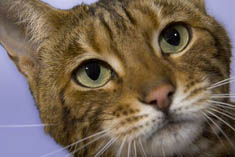Questions and answers – Vidalta® and its use in hyperthyroid cats
Click on the question for the answer.
Most cases of feline hyperthyroidism are caused by benign adenomas of or adenomatous hyperplasia of the thyroid gland. Malignant carcinomas of the thyroid are responsible for around 1-3% of all cases. Read more in Etiology of hyperthyroidism.
The cause of the changes in the thyroid are unknown but may be related to:
- diet
- environmental factors
- genetic mutation
- abnormal immune and/or hormonal responses
Routine hematology and biochemistry rule out other differential diagnoses and most importantly will detect the presence of concurrent diseases in the hyperthyroid cat. Systolic blood pressure measurement is important as many hyperthyroid cats are hypertensive and this may also require management. The results of these tests could influence the treatment protocol to be followed as well as enable you to give the owners a more accurate prognosis with regard to the recovery of their cat.
A number of cases are recognized in which normal T4 concentrations are found despite clinical suspicion of hyperthyroidism. Significant daily variations have been shown to occur in T4 concentrations in hyperthyroid cats and levels may occasionally fall within the normal range (Peterson and others 1987, Broome and others 1988).
The first step in further investigation of suspected cases of hyperthyroidism which show normal T4 concentrations is to repeat a basal T4 estimation. At least one week should elapse before this is done since variations in T4 concentrations may not be short-term. If normal T4 concentrations are again found, dynamic testing of thyroid function should be considered.
The T3 suppression test assesses the negative feedback control of T4 production, which is abnormal in hyperthyroid cats.
The TSH and TRH stimulation tests can also be used. The theoretical basis of stimulation tests is that in hyperthyroidism the thyroid response to stimulation is blunted. The TSH stimulation test has been found to be insensitive and frequently fails to identify hyperthyroid cats. However the TRH stimulation test can help to identify cases of hyperthyroidism with basal T4 concentrations within the normal range.
The recommended starting dose rate for cats with a total T4 <100mmol/L is 10 mg once daily and for those >100mmol/L is 15 mg once daily. Physical examination and repeat blood sampling for total T4 at 10 – 21 days is then recommended. The dose should be adjusted in 5 mg increments as required to achieve/maintain euthyroid status and resolution of clinical signs. Hematology and biochemistry as well as T4 should be monitored relatively frequently especially in the initial stages of treatment. Once the cat is stabilized monitoring can be reduced to every 3-6 months.
Vidalta®/Vidalta® Vet results in rapid normalization of T4 and resolution of clinical signs of hyperthyroidism. T4 may decrease to euthyroid levels in as little as 10 days of commencing treatment.
For hyperthyroidism there is an established relationship between medical treatment and clinical effects (including total thyroxine (TT4)). However, there is huge variation in hormone concentrations between samples in an individual. It is important to record the time between medication and sampling and to record whether the tablet is always given in the same way, since food increases absorption. If medication is sometimes given on a full stomach and sometimes not this will just add to the variation/fluctuations. Slight variations between measurements may reflect natural variation. It is important therefore to judge the results in terms of how they relate to the reference range and of course taking the clinical signs into account. For measurements that are above the upper limit of the reference range this would suggest that treatment is insufficient. In these cases it is worth checking compliance and time from pilling to sampling, consistent manner and time of administration, etc. before changing the dose. Peak concentrations are reached rapidly after Vidalta®/Vidalta® Vet administration and are maintained for some time. There will likely be variation between individuals. Taking all these factors into account the best approach is to standardize the post-treatment sampling time for each case. An alternative is to take a pre-treatment sample. There is reportedly less variability when the sample is taken just before the next dose.


